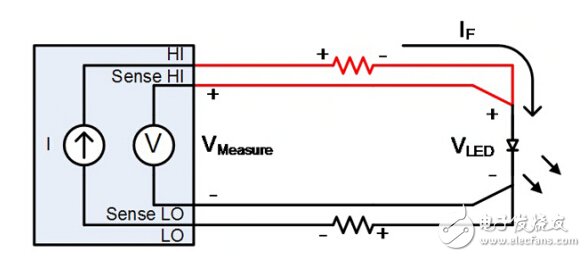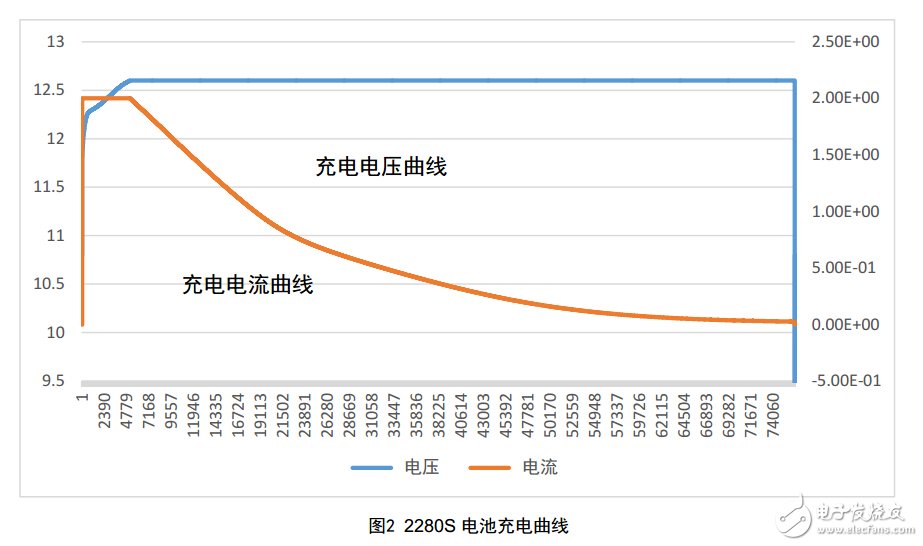Background introduction
The precision measurement power supply can provide high-precision voltage and current measurement while providing stable power supply, so it can be used to test a variety of related parameters. Taking the Keithley PMS 2280S precision measurement power supply as an example, it can continuously and continuously collect voltage and current data during the power supply process, and perform continuous data backhaul through the network interface. Therefore, the user can perform complex processing on the collected data as needed to obtain the final desired result. These processes may include multiply and divide operations to obtain power or resistance information, or integration over the time axis to obtain charge information, and even calculate the capacitance of the supercapacitor based on the recorded charge and discharge slope.
Use 2280S to measure product power or internal resistance
Product internal resistance or DC power consumption under working conditions is often an indicator of customer concern. Taking LED customers as an example, its diode conduction and turn-off characteristics are important indicators for measuring LED performance. In addition, the lifetime and reliability of the LED are closely related to the junction temperature of the LED, and the temperature of the node is difficult to obtain by direct measurement due to packaging. To characterize the thermal performance of an LED, this characteristic is typically described using thermal resistance as a parameter. The calculation formula of thermal resistance is also directly related to voltage and current measurement.
Similarly, relay manufacturers also measure the internal resistance of the relay in the on state, and the smaller internal resistance means lower power loss and longer operating life. In these tests, high-precision voltage and current tests, as well as stable DC power supply, are prerequisites for internal resistance testing under operating conditions.
The internal resistance test of traditional LED customers requires the use of a good current source for power supply, and with a high-precision AD board or multimeter to collect voltage. The connection between the two devices is relatively complicated and the total cost is high. The PMS 2280S power supply can operate in constant current mode (CC mode) and become a good current source. At the same time, its built-in 6.5-digit digital multimeter has unique advantages in voltage and current testing, and its current measurement accuracy can reach micro-ampere level. The resolution is up to 10 nanoamps, the voltage measurement accuracy is millivolts, and the resolution is 0.1mV. After reading back the voltage and current readings, the internal resistance data can be obtained after R = V/I calculation. Open the Data logging function on the LXI web interface, and also continuously collect voltage and current data for a long time, which is beneficial to monitor the change of internal resistance with time under working conditions.
Another problem often encountered when measuring internal resistance is the effect of line resistance. Generally, the on-resistance resistance is small. When the resistance is directly calculated using V/I, the measurement result of the power supply will factor the line resistance on the connection line, causing measurement error. For the PMS 2280S power supply, we offer a four-wire connection on the rear panel of the power supply. Through the four-wire connection power supply mode, the voltage and current value of the power supply readback can be located at the input end of the device to be tested, instead of the output end of the power supply, so that the influence of the line resistance can be completely eliminated, and the measured internal resistance value is More precise, the connection is shown below.

Figure 1 2280S four-wire remote connection
In addition, the built-in Auto Zero feature allows for a quick self-calibration before each voltage or current measurement. The deviation due to internal thermal offset or residual power accumulation is measured and automatically eliminated in the next measurement, further improving the measurement accuracy.
PMS2280S can only output positive phase power. When the reverse voltage needs to be applied to the device under test, we can use the external switch circuit to switch the positive and negative poles to achieve reverse voltage. The positive and negative terminals of the PMS 2280S are isolated from ground, so the negative and negative connections can be used to output a negative voltage. The on/off of the external MOSFET or relay switch can be controlled by the digital IO interface on the rear panel of the PMS2280S. The high-low level of the command can be used to control the on/off operation of the switch. The power supply of the switch can be provided by the USB interface of the rear panel (for example, the power supply current is less than 2mA, and the digital IO port can also be used for power supply).
Measuring the power of a lithium-ion battery with the 2280S
With the enhancement of the functions of electronic products, the battery capacity is also increasing. How to accurately understand the battery capacity becomes an important task of battery testing. The description of the battery level is usually expressed in amps or watts as the unit, indicating the total amount of power entering the battery from the time the battery is emptied to the time it is full. To calculate the charge or discharge of the battery, you need to calculate the charge and discharge current or power of the battery. The calculation formula is as follows:
Total battery capacity  Where t is the charge (discharge) time and I is the charge (discharge) current
Where t is the charge (discharge) time and I is the charge (discharge) current
Total battery capacity  Where I is the sampled current value and ?t is the sample interval
Where I is the sampled current value and ?t is the sample interval
When using the test meter for power test, since the sampling point of the current is discrete, we convert the calculation formula to:
Here, the measuring instrument is required to accurately record the charging or discharging current, and to ensure a high continuous sampling rate, and at the same time, the entire data of the entire charging and discharging process can be completely recorded to ensure that the calculation result is sufficiently accurate.
The PMS 2280S's data logging capability provides up to 3000 voltage or current sample rates per second. And the data can be continuously transmitted back to the computer through the LAN interface. Users can record data for a long time and export all data to an Excel spreadsheet for subsequent analysis. The figure below shows the voltage and current graph of the 2280S charging lithium-ion battery. The battery voltage is charged from 11.8V to 12.6V. The current starts to charge at 2A. When the voltage drops below 20mA, the charging ends.

Figure 2 2280S battery charging curve
When performing the ampere-hour calculation, simply connect the battery to the power supply, set the charging cut-off voltage (Vset), and the charging current (Iset), at which point the power supply will automatically start charging the battery. The initial stage uses constant current charging (CC mode). When the voltage rises to the charging cut-off voltage, it will automatically switch to constant voltage charging (CV mode) until the current decreases to near zero.
In addition to charging the battery, the PMS 2280S can also perform a discharge test on the battery. Since the voltage and current are uncontrollable during discharge, the power supply will absorb current (about -450 mA) with maximum capacity and continuously record the voltage and current values ​​during discharge.
The voltage and current data during charging and discharging can be continuously recorded through the computer, and the user does not need to write any software. Output the IP address of the power supply on the web browser of the computer, select the Data logging function in the lower left corner of the screen, and use the built-in web interface of the instrument to complete the recording of all data. The total charge or discharge of the battery will also be automatically displayed in milliamp hours as shown below:

Figure 3 2280S data logging interface
Weighing sensor a kind of force sensor used on weighing apparatus. The principle of resistance strain type weighing sensor, which can convert the gravity acting on the measured object into measurable output signal according to a certain proportion. The influence of gravity acceleration and air buoyancy in different locations on conversion, the performance indexes of weighing sensor mainly include linear error, lag error, repetitive error, creep, zero temperature characteristics and sensitivity temperature characteristics, etc.
Single Ended Shear Beam Load Cell
Floor Scale Load Cell,Shear Beam Load Cell,Rail Scales Load Cell,Platform Scale Load Cell
Ningbo Santwell Imp & Exp Co.,Ltd , https://www.santwell.com